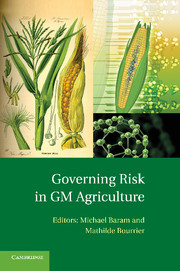Book contents
- Frontmatter
- Contents
- Preface
- Contributors
- 1 Governing Risk in GM Agriculture
- Part I Risk Governance and Public Discourse
- Part II Future Challenges
- 6 Coexistence and Traceability of GMOs in the Agro-Food Sector
- 7 The “Pharming” Challenge
- 8 GMO as a Sustainability Issue
- 9 Applying Safety Science to Genetically Modified Agriculture
- Index
- References
7 - The “Pharming” Challenge
Published online by Cambridge University Press: 01 March 2011
- Frontmatter
- Contents
- Preface
- Contributors
- 1 Governing Risk in GM Agriculture
- Part I Risk Governance and Public Discourse
- Part II Future Challenges
- 6 Coexistence and Traceability of GMOs in the Agro-Food Sector
- 7 The “Pharming” Challenge
- 8 GMO as a Sustainability Issue
- 9 Applying Safety Science to Genetically Modified Agriculture
- Index
- References
Summary
Introduction
Since the mid-1990s, an increasing number of research papers have described the production of substances of industrial interest from genetically modified (GM) plants, also referred to as “molecular farming.” As a fundamental difference to present-day industrial crops, most of these substances are not naturally occurring in these plants. The majority of R&D activities have so far focused on high-value proteins and especially on biopharmaceuticals (plant-made pharmaceuticals or PMPs) such as vaccines, monoclonal antibodies, therapeutic enzymes, hormones, and interferon. Furthermore, plants are used for the production of enzymes and other substances such as fatty acids, bioplastics, spider silk, and gelatine (plant-made industrials or PMIs) that can be used in various industrial sectors.
For producing these substances, a broad range of such GM crops have been successfully grown in the open field including maize, tobacco, rice, safflower, potato, rape, soybean, and barley.
The main drivers of molecular farming seem to be economic and technical in nature: scaling-up of production of substances by simply enlarging the cultivated area for such crops is considered an asset over presently used bioreactors that require expensive high-tech buildings, machinery, and equipment and a time-consuming process for optimizing production. This enables producers to quickly adjust to changing market requirements. Plant molecular farming would also provide sufficient capacity to manufacture biopharmaceuticals well beyond 10,000 kg/year – which constitutes the highest annual tonnage presently derived from microbes or mammalian cell lines.
- Type
- Chapter
- Information
- Governing Risk in GM Agriculture , pp. 169 - 200Publisher: Cambridge University PressPrint publication year: 2010



